| New York Architecture Images- Notes | ||||||
| Notes from the
underground in New York
|
||||||
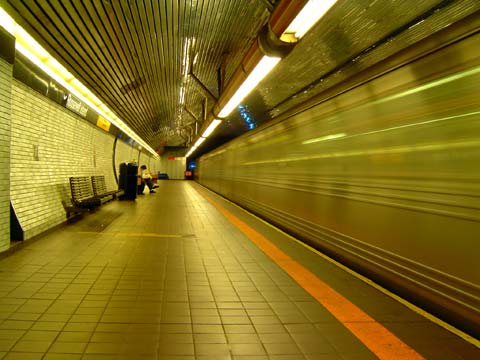
photo ann marie hughes |
||||||
|
||||||
|
STREETSCAPES/New York's Subway; That
Engineering Marvel Also Had Architects By CHRISTOPHER GRAY Published: October 10, 2004, Sunday THE subway system, which opened nearly 100 years ago, on Oct. 27, 1904, is one of New York's most astonishing engineering projects -- miles and miles of track strung through a dense network of building foundations, basements and water, gas, electric and sewage lines. But it was also an architectural effort --the lacy iron street kiosks, the careful marble and tile subway stations, the delicate faience tile decorations. And Heins & LaFarge were the architects who did it. George L. Heins and Christopher Grant LaFarge met as students at the Massachusetts Institute of Technology around 1880 and then worked in the architectural office of Cass Gilbert. In 1886, they set up their own New York practice. They did some designing for LaFarge's father, the painter, stained-glass artist and muralist John LaFarge. But by 1891, they had done little of note when they suddenly struck oil, winning the competition for the Cathedral Church of St. John the Divine at Amsterdam Avenue and 112th Street. Only fragments of their original design survive -- the cathedral as built is drastically different -- but their principal elements were a south-facing exposure, looking down over the city from the site's high bluff; a Byzantine decoration of mosaics and murals; and a great wide interior, so unlike the relatively narrow English Gothic models typical for churches at that time. The next year, they designed the lovely villagelike church at 91st Street and West End Avenue -- now the Annunciation Greek Orthodox Church. In 1896 they got another plum commission, the buildings of the Bronx Zoo, witty neo-Classical temples festooned with heads of elephants, turtles, cockatoos and other wildlife. They later designed several unusual town houses, like the Greek/Renaissance Bowen house at 5 East 63rd Street (1900) and the Bliss house at 9 East 68th (1905), with its giant-columned facade. In the spring of 1900, Heins & LaFarge met the financier August Belmont, head of the consortium that was building New York's first underground mass transit system. Belmont donated a chapel to St. John the Divine and may have encountered Heins & LaFarge through that connection. The following March, they were appointed architects for the first subway line, to run from City Hall to Grand Central, across to Times Square, and up Broadway to West 145th Street. For such a huge work of engineering, any architectural design was little more than window dressing -- the stations were not even free-standing, as they would be with a railroad. The architects did design the little cast iron, wire and glass kiosks aboveground at the station entrances, and several aboveground brick and stone shelters, like those at Bowling Green and West 72nd Street. Although the shelters look charming to modern eyes, they were roundly condemned when built. ''A miserable monstrosity as to architecture,'' The New York Times wrote in a 1904 editorial about the shelter at 72nd Street and Broadway. But the architects' toughest charge was the stations themselves, narrow platforms in what was essentially an industrial environment. Their most obvious additions are the distinctive terra cotta plaques and mosaic designs. The Columbus Circle station features the Santa Maria, one of Columbus's ships, with billowing white sails on a green sea with tiny white seagulls. For stations without obvious symbolic connections, they designed elegant mosaic work, like the great curved panels in the walls of the West 72nd Street station, with a chain of flowers connected by red rope. The gallery wall for these artworks was the stations' basic finish: lovely straw-colored iron-spot brick; mosaic bands and terra cotta cornices and friezes; and glassy white tile, to reflect light from glass vaults in the sidewalks above. The ceilings are networks of decorated plaster strips and intricate cast-iron ceiling fixtures flush with the surface. The centerpiece was the domed City Hall station, no longer in service. Despite their success, disappointment loomed. Heins died in 1907, and the trustees of St. John the Divine had become disenchanted with the medieval character of the 1891 design -- and also with Heins & LaFarge themselves, believing they had spent too much time on the subway contract. Four years after Heins's death, the Gothicist architect Ralph Cram worked in secret to wrest the cathedral contract away from LaFarge. He reoriented the building plan to face Amsterdam Avenue and restyled it in the Gothic. According to Andrew Dolkart's ''Morningside Heights: A History of Its Architecture and Development'' (Columbia University Press, 1998) LaFarge never spoke of his profound disappointment, but much later wrote Cram, calling the cathedral episode a ''greasy performance.'' LaFarge -- by himself and in partnership with others -- went on to design a variety of buildings, elegant but often rather spare, like the 1915 Brooks Brothers headquarters at 44th and Madison, and the 1929 New York Genealogical and Biographical Society, at 122 East 58th Street, a work of Bostonian reserve. He died in 1938. By the 1940's, the subway system had begun a long decline. The vaulted City Hall station closed in 1945, and the delicate kiosks were destroyed; in 1956 a letter to the editor of The Times from Dan Wallack noted that ''two ugly, grimy I.R.T. subway kiosks'' still survived at Columbus Circle, calling them ''anachronistic monstrosities.'' The platforms in the rest of the system were brutally extended to accommodate longer trains; their institutional tile walls give them the look of a grubby housing project. The elegant old incandescent fixtures were replaced by fluorescent ones, and the decorative trim was gouged, drilled or simply demolished. A reversal began in the 1980's, when the architects Prentice & Chan, Ohlhausen replicated one of the original kiosks at Astor Place. Other restorations have followed, like those of the brick and stone shelters at Bowling Green and West 72nd Street. West 72nd also features the latest and most sophisticated of the station platform restorations. The subway system celebrates its centennial this month, and there are several Web links to online narrated gallery talks, photo exhibitions and similar activities. The Metropolitan Transportation Authority's Web site, www.mta.info, also connects to the New York Transit Museum. Another site, www-tech.mit.edu/Subway, has historical photographs of every original station. There is also a great deal of information on a third site, www.nycsubway.org. Look For For the station at Bleecker and Lafayette Streets, the subway's architects, Heins & LaFarge, designed a broad oval medallion, glazed faience in cobalt blue, with white letters. At Astor Place and Fourth Avenue, the walls have a reproduction of a beaver, a reference to the multimillionaire John Jacob Astor's start as a fur trader. BUILT -- 1904 ADDRESS -- Bleecker and Lafayette Streets; Astor Place and Fourth Avenue. HOW TO GET THERE -- No. 6 train to Bleecker Street or Astor Place. Published: 10 - 10 - 2004 , Late Edition - Final , Section 11 , Column 4 , Page 11 Copyright New York Times. |
||||||
|
||||||
New York subway trip
|
The 722-mile lifeline, which carries 7 million people daily, is also relatively safe and clean. "People have an idea that it's a rat's nest full of crime," said Brian J. Cudahy, author of "A Century of Subways" and several other books dealing with New York's transit history. "None of that is true."
But it takes a daylong, crisscrossing trip on the trains to understand that, and to take in all the subway has to offer.
If you're looking for music, you'll most likely find it in busy midtown Manhattan stations. Some performers are sponsored by the Metropolitan Transportation Authority and have official "Music Under New York" signs, such as the trio of young women who often play classical strings near the turnstiles at the Rockefeller Center stop; others just show up, impromptu, with a guitar, drum or accordion and put on shows in between the noisy trains' arrivals and departures.
If you need a snack, many stations have newsstands that sell candy, drinks and other goodies. But you can also find the occasional
unsanctioned entrepreneur peddling something slightly more exotic, like churros -- sweet sticks that taste like doughnuts -- sometimes found in stations downtown.
For the best views, however, you'll need to leave Manhattan, where the system is largely underground, to access the elevated lines. Start your trip on an early autumn morning, taking the D train across the Manhattan Bridge, where you'll be greeted by the sight of its better-known cousin, the Brooklyn Bridge. A 7 a.m. sunrise shimmers over the East River, and looking south through the train windows, you'll be saluted by the Statue of Liberty, four miles away. To the north is the familiar Manhattan skyline, anchored by the distinctive shapes of the Empire State Building and the Chrysler Building.
But a ride over the East River isn't the only spectacular view a subway trip offers.
Far on the eastern portion of Queens, the A train begins its 31-mile run, but not before passing two of the city's most interesting landscapes.
First, it takes a 10-minute ride through the Jamaica Bay Wildlife Refuge, a marshland where swallows and egrets can be spotted along with plants and wildflowers that would commonly be found anywhere but New York.
From there the A train heads to John F. Kennedy International Airport, which displays a continual ballet of arriving and departing aircraft over the Atlantic Ocean-fed Jamaica Bay.
Transferring from the A to the Manhattan-bound L train at the Broadway Junction stop, riders get an aerial view of Brooklyn rooftops as the train winds and twists like a roller coaster on a 50-foot high elevated track. The next two stops offer views of historic Evergreen Cemetery, which boasts the graves of celebrities like Bill "Bojangles" Robinson and Tony Pastor, the father of Vaudeville, and extends for miles of greenery over the borough's Cypress Hills section to the border of Queens.
Once the L goes back into the tunnel, transfer to the Queens-bound G train at Metropolitan Avenue. At the last stop, Long Island City, change to the Queens-bound No. 7, which also runs above ground. Look for the Citibank skyscraper; at 48 stories, it is the tallest building in Queens. Its green glass exterior acts like a mirror, brightly reflecting sunlight around the neighborhood. Nearby (at Jackson Avenue and Crane Street) you can see a building known as "5 Pointz"; its walls are covered with graffiti, the tags of urban Picassos from around the world.
As the No. 7 continues eastward, passing through the ethnically diverse neighborhoods of Woodside, Jackson Heights, Corona and Flushing, it earns its nickname as the "international line." Here you'll find riders speaking everything from Spanish to Pakistani Urdu to Korean.
Soon the train passes by Flushing Meadows Corona Park, Queens' largest public park and home of the Unisphere, the biggest globe in the world. The hollow steel structure, 120 feet tall, was erected for the 1964 World's Fair.
During baseball season, as the train nears Shea Stadium, it is often filled with Mets fans in their blue caps and "Piazza" jerseys; you'll also notice low-flying planes here, headed to and from LaGuardia Airport.
The train continues into Flushing and winds up underground, emptying out at the last stop. By now, it's afternoon; stay on the No. 7 and double back into Manhattan, where you can change to the No. 4 train at Grand Central, the city's most famous station and one of its busiest. Four subway lines and the Metro North Commuter Railroad (which goes to suburban Westchester, upstate New York and Connecticut) meet here. If you want a glimpse of Grand Central's famed concourse, with its landmark clock and vaulted ceiling painted to look like a starlit sky, you'll have to leave the subway system and pay again to enter. Or buy a $4 unlimited pass when you get on so you can leave and come back as many times as you want for 24 hours.
Back on the uptown or Bronx-bound No. 4 running along Manhattan's Upper East Side, you'll find examples of the system's underground artwork. At the 59th Street station, the underpass displays Elizabeth Murray's colorful glass mosaic called "Blooming," which covers the walls with bright red trees, coffee cups and blue backgrounds. Farther up, look for mosaic tile works at 96th, 103rd, 110th and 125th streets on the local line.
In the Bronx, the train eventually emerges above ground for a view of the familiar blue bleachers at Yankee Stadium at 161st Street and River Avenue. Get off here and wind your way back to Manhattan via a series of transfers that will make you feel like a real New Yorker: Take the D to 145th Street, then head back uptown for just a couple of stops, to 168th Street, where you can switch to the downtown Nos. 1 or 9.
Here an amazing feat of engineering is revealed: A two-track mine tunnel blasted through solid bedrock sits here, one of the deepest sections of the system and part of the first routes that opened 100 years ago.
Around 6 p.m., the window of the southbound No. 1 train from northern Manhattan affords what may be the subway system's most dramatic view: The sun setting over the Hudson River and behind the hills of New Jersey, with urban Harlem in the foreground. Then the train goes underground again, past the welded-steel throne sculptures at the 116th Street station (Columbia University), the Alice in Wonderland mosaic at 50th Street, and "The Return of Spring" mural at Times Square.
After a dozen hours in the subway, any tourist would be exhausted, even though the day's trip did not cover even half the system. But some people think riding the train is as much fun as reaching any given destination.
"Out of all the subway systems I've ridden," said Trevor Logan, a subway maven who participates often in online chat rooms devoted to transit, "you only get this in New York."
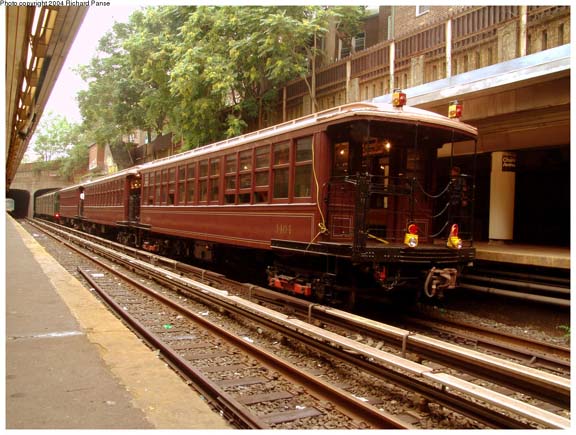
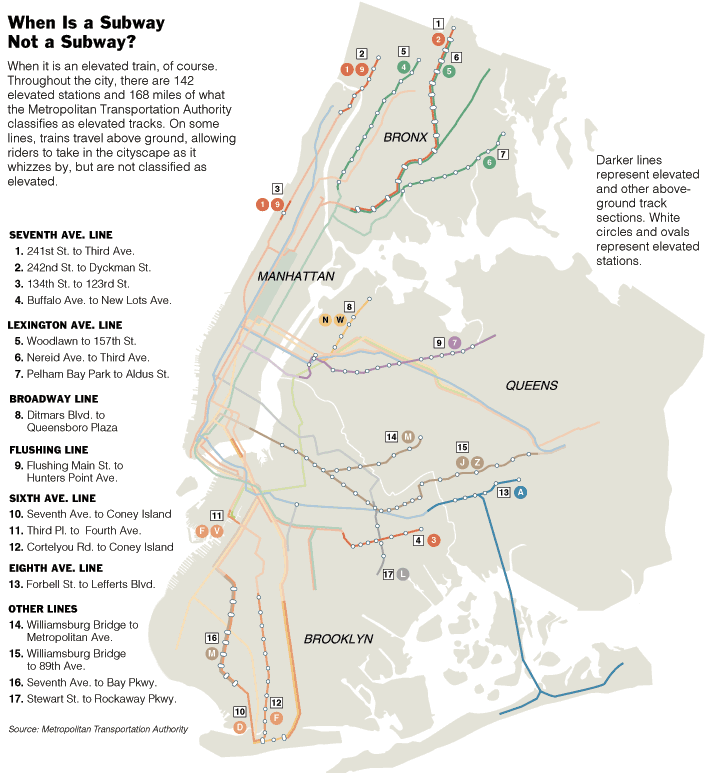
|
The brick and stone subway station entrance at 72nd Street and Broadway was designed by Heins & Lafarge and built in 1904. The number of subway riders who use this entrance today far exceeds its designers' modest expectations.
The interior of the control house is an Interior Landmark. It was rebuilt in 1989. The station platform below the street is extremely narrow and doesn't allow for passengers to transfer between the uptown and downtown sides. It has become extremely uncomfortable and is in constant threat of demolition.
Designed by Henry J. Hardenbergh, the Dakota apartment hotel took four years to build. The immense structure could be seen from both rivers. "People who like to live between life and movement, and yet to have pure air and quiet and to be near some of the great parks, naturally gravitate to upper Broadway." -- New York American, "Renting Guide to High Class Apartments," 1911.
Visible in this 1907 photo of Sherman Square are, from left to right behind the control house, the Colonial Club, Rutger's Church and the Ansonia Apartment Hotel. Built the same year as the station, the Ansonia was designed by Graves and Duboy. Duboy was particularly enamored of the forms of Parisian apartment buildings. Such notables as Flo Ziegfeld and Igor Stravinsky have stayed here.
Heins & Lafarge designed these black-painted cast-iron and wired glass subway kiosks at 23rd Street and 4th Avenue (1905). The number of kiosks at any one station varied from two to eight and each was slightly different from the others. All have been destroyed over the years. The one pictured in color below is a modern reconstruction at Astor Place.
These brick and stone entrances were once called "control houses," the idea being that once you entered you were under the "control" of the Transit Company. The term control house is no longer used. This Heins & Lafarge control house once stood at 116th Street and Broadway.
Once a bucolic, tree-lined boulevard with a scattering of private homes, Broadway, thanks to the subway, is now a congested, commercial thoroughfare. The churches around Sherman Square made way for shops and banks. In 1906 the Colonial Club Building, seen here behind the station, was renovated to be used as offices.
|
THE UPPER WEST SIDEWest 72nd Street in New York City was once an unpaved, picturesque boulevard and main carriage route from Central Park to Riverside Drive. It traversed what was essentially countryside until June of 1879, when the New York Elevated Railroad began carrying passengers up Ninth Avenue (later named Columbus Avenue) to the Harlem River at 145th Street. The train brought an ever increasing number of people north. According to Egbert L. Viele, the engineer of the railway, many began to see it as an area "for development on a higher order of domestic architecture than had been the good fortune of New York to hitherto possess." The most adventuresome of the new breed of developers was Edward Clark, head of the Singer Sewing Machine Company, who after building a row of 27 private homes, invested $1 million in his family hotel at Central Park West and 72nd Street, later known as the Dakota. Immediately following the success of the Dakota (every apartment was rented by opening day) other apartment hotels sprang up nearby. Toward the end of the 1890s, William Earle Dodge Stokes decided to build the world's grandest hotel on the Upper West Side, a great Beaux Arts style mass of scrolls, brackets, balconies, and cornices called the Ansonia. By 1895, $2 million had been invested in buildings in the area, according to The New York Times in an article headed "West Side is itself a Great City." This unprecedented development beyond the city limits would only continue with the advent of the new underground train system called the "subway." Just as changes in the neighborhood would determine the future configuration of the subway, the subway itself would dramatically change the future of the neighborhood. Private homes gave way to enormous apartment buildings, especially near the 72nd and 96th Street express stops. Broadway became a commercial thoroughfare. In 1906 the Colonial Club Building was renovated to be used as offices; churches around Sherman Square made way for offices and banks. UNDER THE CITY'S STREETSSerious consideration was given to building a rapid transit system in New York City as early as the 1860s, when the streets of lower Manhattan were choked with slow-moving traffic. Many proposals were made, most inspired by the first subway in the world, which opened in London in 1863. After delays in construction due to expense, political squabbling, and technological obstacles, a plan allowing a subway to be built with city funds was overwhelmingly approved in a referendum in 1894. A public rapid transit board was formed and laid out the route, which ran from a point near City Hall to 42nd Street, then west to Times Square, and then north to Broadway to 96th Street, where the line divided. One branch continued along Broadway to 242nd Street, the other went along Lenox Avenue and under the Harlem River to the Central Bronx. Bids were solicited in 1900; the contract awarded for $35 million to the Rapid Transit Subway Construction Company, leased the subway to the contractor for fifty years. Construction began in March of that year with a ground breaking ceremony at City Hall. In 1902 the Interborough Rapid Transit Company was formed to operate the subway. It was awarded a second contract to build a line running south from City Hall under Broadway and the East River to downtown Brooklyn. Although trained as an engineer, William Barclay Parsons, Chief Engineer of the Rapid Transit Commission, appreciated the architectural possibilities of the subway project. He saw the subway as a unified structure, more like a "horizontal building" than a tunnel, deserving of coherent design. He also recognized that these were exciting times for architecture itself. New technologies and materials, such as reinforced concrete, were making structures possible that were until now unimaginable. It was Parsons who found the team to bring all this together, George C. Heins and Christopher Grant Lafarge. They were appointed architectural advisors on March 7, 1901 at an annual fee of $2,500. THE SUBWAY'S ARCHITECTSParsons couldn't have found a better team. Heins & Lafarge were already well respected architects working on a number major projects in the city. They were also the brother-in-law and the son, respectively, of John Lafarge, the muralist and stained glass designer who was a leader in the Arts and Crafts movement. Christopher Lafarge inherited his father's sense of color and design and was a leader, in his own right, in the revival of the decorative arts. Heins acted essentially as the builder and administrator for the firm while Lafarge was essentially the designer. Heins & Lafarge designed a number of distinguished religious and public buildings. In 1891 they won a competition for the initial Byzantine-Romanesque design of the Cathedral of Saint John the Divine; the choir, crossing, and the side chapels were added by the firm between 1892 and 1911 (after the death of Heins the firm was replaced by Cram, Goodhue and Ferguson). Heins and Lafarge also designed the Clergy Houses of Grace Church (1892), the administration building (1899) and six animal houses (1910) at the New York Zoological Gardens in the Bronx. The Bronx Zoo is the largest zoo in the United States and is a leader in the care, feeding, and exhibition of animals. KIOSKS AND CONTROL HOUSESAlthough New York modeled its subway on the London Underground, planners adopted the Budapest station plan; the subway in Budapest opened in 1896. The Hungarians, unlike the English, did not build surface structures that resembled railroad terminals. Instead, they borrowed a design from the gardens of ancient Persia and Turkey, where oddly shaped summer houses, called "kushks" abounded. New York's subway engineers Americanized the word kushks to kiosks. The first subway, under City Hall, consequently had strangely ornamental mosque-like kiosks, which Heins & Lafarge designed to be fabricated out of steel and wired glass instead of stone and tile. Kiosks also were believed to be functional; without such protection rain would pour in and platforms would become flooded. Where roomier "islands" on the city's streets allowed, so-called "control houses" were built as entrances to the subway. On upper Broadway, Heins & Lafarge designed three stone, skylighted control houses at 103rd and 116th Streets as well as at Sherman Square. They also designed control houses for Bowling Green in lower Manhattan and at Boerum Hill in Brooklyn. A great deal of care went into the look of the system. The main power house for example, at 59th Street and West End Avenue, could easily have been a typically innocuous, industrial structure. Instead, it is a magnificent Beaux Arts building designed by Stanford White. In a detailed description of the subway's construction, published in 1904 by the Interborough Rapid Transit Company, it is noted that "strength, utility, and convenience have not alone been considered, but all parts of the railroad structures and equipment, stations, power house, and electrical sub-stations have been designed and constructed with a view to the beauty of their appearance, as well as to their efficiency." New Yorkers had good reason to be proud of their subways. |
| All photos are in the public domain or are ©Roger and Susannah Shepherd. | |
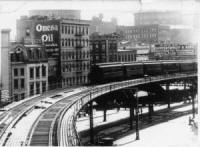 1863
World's first subway opens in
London.
1863
World's first subway opens in
London.
1870 First Manhattan elevated line opens.
1883 Brooklyn Bridge opens with cable railway service between Brooklyn and Manhattan
1885 First elevated line in Downtown Brooklyn
1894 Rapid Transit Commission formed; first electrified rapid transit in New York area.
1897 Rapid Transit Commission presents subway plan for New York; first US subway opens in Boston
1900 Ground breaking for subway
1901 Cable cars are replace by streetcars from Houston Street to Bowling Green.
1903 The last steam train on the 6th Avenue El is replaced by cleaner, faster electric cars. Ten subway workers die in worst subway construction disaster - a roof collapse in Ft. George Tunnel.
1904 First official
Manhattan subway system, the Interborough Rapid Transit (IRT), opens on
October 27th.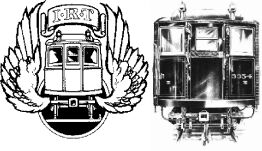 Mayor McClellan takes the controls for part of the inaugural run from City
Hall to West 145th Street. It consists of 28 stations from City Hall to
145th Street, along 9.1 miles of track. The IRT extends to the Bronx in
1905, Brooklyn in 1908 and Queens in 1915.
Mayor McClellan takes the controls for part of the inaugural run from City
Hall to West 145th Street. It consists of 28 stations from City Hall to
145th Street, along 9.1 miles of track. The IRT extends to the Bronx in
1905, Brooklyn in 1908 and Queens in 1915.
1908 New subway tunnel connects Bowling Green in Lower Manhattan to Brooklyn Borough Hall.
1915 The Brooklyn Rapid Transit Company, later known as the Brooklyn-Manhattan Transit (BMT), opens a subway between Brooklyn and Manhattan.
1932 NYC's Board of Transportation completes construction of the Eighth Avenue Line, creating the Independent City Owned Rapid Transit Railroad or the IND.
1940 NYC purchases the BMT and IRT, becoming the sole owner and operator of all NYC subway and elevated lines.
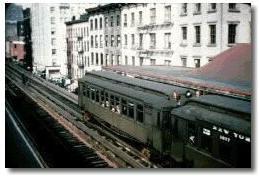 1953
The New York State
Legislature creates the New York City Transit Authority, located at 370
Jay Street in downtown Brooklyn, to manage and operate the subway
system..
1953
The New York State
Legislature creates the New York City Transit Authority, located at 370
Jay Street in downtown Brooklyn, to manage and operate the subway
system..
1953 On July 25, Tokens debut in the subway. Fare raised to 15 cents.
1954 On October 30, a track connection opens between Brooklyn's Church Avenue and Ditmas Avenue stations. This establishes single-route service (on the D) from the Bronx at 205th Street to Brooklyn's Coney Island.
1955 On May 12, The Third Avenue El, the last elevated line in Manhattan, is discontinued and the former BMT and IND lines are linked in Long Island City, Queens.
1955 On December 1, a track connection opens between the 60th Street tunnel and the Queens Boulevard line, linking former BMT and IND lines in Long Island City, Queens.
1956 On June 28, subway service begins operating to Rockaway Park and Wavecrest in Queens.
1958 On January 16, subway service extends to Far Rockaway/Mott Avenue in Queens.
1959 NYC sells its rapid transit power plants to Con Edison and the NY Power Authority which uses the Con Ed network to supply power to New York City Transit.
1965 First use of two-way radio system to link Lexington Avenue trains to control towers and the central command center.
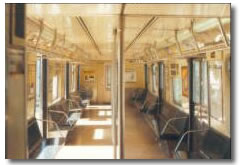 1966
A strike by unionized employees shuts down bus and subway service for 12
days. Fare raised to 20 cents.
1966
A strike by unionized employees shuts down bus and subway service for 12
days. Fare raised to 20 cents.
1967 On November 26, The Christie Street connection opens, enabling BMT lines that cross the Manhattan and Williamsburg Bridges to stop at Broadway-Lafayette (an IND station). The Grand Street station also opens to serve trains using the Manhattan Bridge (B D and Q routes).
1967 First air conditioned subway cars go into service on the F line.
1968 On March 1, The New York State Legislature creates the Metropolitan Transportation Authority which becomes New York City Transit's parent organization.
1969 The Myrtle Avenue Elevated in Brooklyn closes.
1971 On July 1, The city purchases the Staten Island subsidiary of the Baltimore and Ohio forming the Staten Island Railway .
1972 Construction is started on the Archer Avenue line in Queens; the Jamaica Avenue El in Queens is demolished.
1973 The Third Avenue El in the Bronx is closed.
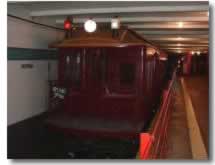 1976
On July 1, The Transit Exhibition (now called the
NY Transit Museum) is opened in Brooklyn.
1976
On July 1, The Transit Exhibition (now called the
NY Transit Museum) is opened in Brooklyn.
1980 A strike by unionized employees shuts down bus and subway service for 11 days.
1982 First 5-year Capital Improvement Program provides for subway fleet replacement and overhaul, mainline track improvements, facility and station renovations.
1984 A Track Geometry Car is put into service inspecting track conditions.
1986 Fare is raised to $1.
1987 The second 5-year Capital Program begins.
1988 On December 11, The Archer Avenue line opens, consisting of three stations and linking the Jamaica (J) and Queens Boulevard (E) lines in Queens. Six southeast Queens bus routes are rerouted to serve the city's first modern intermodal (bus-rail) transfer facility at the new Jamaica Center (Parsons-Archer) station.
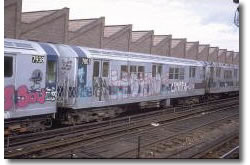 1989
On May 12, NYCT wins its
five year war on graffiti. The last vandalized train is taken out of
service. The 63rd Street extension features three new stations at
Lexington Avenue, Roosevelt Island and 21st Street in Long Island City.
1989
On May 12, NYCT wins its
five year war on graffiti. The last vandalized train is taken out of
service. The 63rd Street extension features three new stations at
Lexington Avenue, Roosevelt Island and 21st Street in Long Island City.
1991 No. 4 train derailment killed five passengers and injured more than 200.
1992 On October 30, Transit begins to install the first Automated Fare Collection (AFC) turnstiles. Two New Technology Test Trains are introduced to the public. Fare is raised to $1.25.
1993 The third Capital Program is approved, providing for the 63rd Street Tunnel extension, station rehabilitation, signal, fan and pump modernization and increased maintenance of the fleet and track.
1994 On January 6, Automated Fare Collection (AFC) turnstiles go on-line at the Wall Street (4 5) and Whitehall Street (N R) stations.
1994 On September 22, construction begins on the 63rd St. tunnel connector, which will link the 63rd St. line to the Queens Blvd. line in Long Island City, Queens.
1995 On April 2, the New York City and Transit Police Departments merge.
1995 On November 12, Subway and local bus fare becomes $1.50. A "Five Borough," token replaces the "bulls-eye" design.
1996 The 207th St. Overhaul Shop becomes a "commingled" shop of OA and TA maintainers. The shop focuses on bus remanufacturing and replacing of wheelchair lifts in targeted buses. A state of good repair is achieved for all mainline switches.
1996 On January 7, The largest blizzard in almost 50 years dumps 20 inches of snow on New York City. Underground sections of subway routes continue service. System begins accepting the electronic Metrocard.
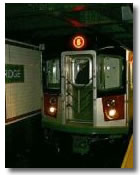 1997
NYCT orders 1,080 new subway cars, the largest single purchase in its
history: 680 R142's from
Bombardier
and 400 from Kawasaki.
1997
NYCT orders 1,080 new subway cars, the largest single purchase in its
history: 680 R142's from
Bombardier
and 400 from Kawasaki.
1997 On May 14, The entire New York City Transit bus and subway system accepts MetroCard, as the last AFC turnstiles go on-line.
1997 On July 4, MetroCard Gold debuts, allowing customers to transfer free bus to subway, subway to bus, and bus to bus.
1998 On January 1, A new MetroCard offer lets customers get 11 rides for the price of 10.
1998 On July 4, First sales day for Unlimited-Ride 7-day and 30-day MetroCards, which let customers take as many trips as they want for a fixed price.
1998 On October 12, Lenox Avenue Invert completed. The $82 million project rebuilds the flooded invert (floor) of the Lenox Ave (2 and 3) line between 110 and 116 Sts and restores the 116 St. station. Work finishes in less than eight months.
1999 NYCT accepts delivery of the first ten R142a cars from Kawasaki and five R142 cars from Bombardier.
1999 On January 1, Fun Pass introduced. This unlimited-use, One-day MetroCard is priced at $4.
1999 On January 25, MetroCard Vending Machines (MVM) debut in two subway stations. By the end of the year, 347 MVMs are in service in 74 stations.
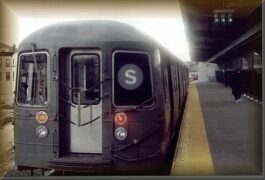 1999
On October 18th,
The Franklin Avenue Shuttle re-opens after a $74 million
rehabilitation, three months ahead of schedule.
1999
On October 18th,
The Franklin Avenue Shuttle re-opens after a $74 million
rehabilitation, three months ahead of schedule.
2000 NYCT celebrates the Centennial of the original groundbreaking ceremony for the city's subway system held March 24, 1900.
2001
On July 22, 2001, the 6th Av. side
of the Manhattan Bridge was closed till approximately 2004. The
Broadway side of the bridge was re-opened for the first time since 1990.
2001 The World Trade Center collapses due to a terrorist attack on September 11. There was a partial collapse of the Cortlandt Street Station underneath the complex. IRT Broadway 1/9 service is shut down between Chambers Street and South Ferry.
2002 Service on the 1/9 Broadway Line was restored in September, 2002. Cortlandt Street station remained closed until plans are finalized and major construction of Ground Zero is underway.
2002 On October 10th, MTA Chairman Peter Kalikow announced a major restructuring of MTA agencies. MTA New York City Transit was officially separated into two separate companies called MTA Subways and MTA Buses. MTA Subways will operate all of the subway lines including Staten Island Rapid Transit.
 2003
It was the death of an icon as New York City's subways and buses stop
accepting tokens, as the MTA hikes fares by 33% from $1.50 to $2.00. It
is the largest increase in city history.
2003
It was the death of an icon as New York City's subways and buses stop
accepting tokens, as the MTA hikes fares by 33% from $1.50 to $2.00. It
is the largest increase in city history.
2003 State and city agencies began planning a new transportation hub at the World Trade Center site.
2004 The New York City Subway celebrates its centennial with many events and nostalgic train rides. MTA pushes ahead with a $16 Billion Second Avenue Plan, slated for 2011 completion.